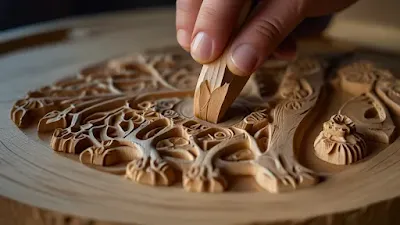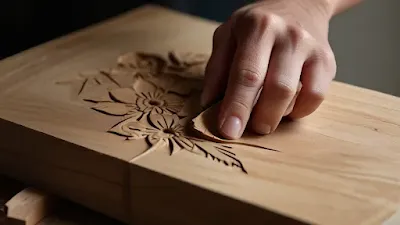The art of woodcarving has captivated humanity for millennia. From intricate totem poles to delicate figurines, carved wood has served as a canvas for storytelling, artistry, and functionality. Today, woodcarving remains a captivating hobby, offering a unique blend of creative expression, satisfaction, and connection to a timeless tradition.
But where do you begin? Whether you're a complete novice or a seasoned carver looking for inspiration, this guide offers a treasure trove of woodcarving ideas suited for every skill level. We'll delve into:
Beginner-Friendly Projects: Taking Your First Strokes
Embarking on your woodcarving journey can be both exciting and daunting. Here, we'll explore some fantastic project ideas that are perfect for beginners, allowing you to build confidence and hone your fundamental skills:
- Carved Spoons: A spoon is a practical and beautiful project to kickstart your carving experience. Begin with a simple wooden blank. Use a palm gouge to create the bowl's gentle curves and a detail gouge to carve the handle. Sand the spoon smooth for a polished finish. This project allows you to practice basic cuts while creating a functional and aesthetically pleasing object.
- Geometric Pendants: Geometric shapes are a fantastic way to practice push cuts, control, and overall technique. Choose a simple design like a triangle or a square. Use a combination of push cuts and whittling to refine the shape. Drill a small hole at the top and add a cord to transform your creation into a unique pendant. This project allows for experimentation and personalization.
- Whimsical Stamps: Carving your own stamps is a fun and practical project. Start with a small piece of wood with a flat surface. Use a detail gouge to carve a simple design, like a flower, animal silhouette, or initials. Mount the carved piece onto a rubber stamp block, and you're ready to create custom-stamped designs on paper, fabric, or even baked goods! This project encourages creativity and allows you to add a personal touch to various crafts.
Stepping Up Your Skills: Intermediate Projects
As you gain confidence and refine your technique, you can delve into more intricate and challenging projects. Here are some captivating ideas to elevate your woodcarving journey:
- Relief Carvings: Relief carving involves creating a raised design on a flat wooden surface. This project allows you to explore the depth and dimension of your carvings. Start with a simple design like a leaf or a geometric pattern. Use a combination of gouges and chisels (if comfortable) to remove background wood, gradually revealing your raised design. Relief carvings are excellent for creating decorative wall hangings or personalized plaques.
- Carved Bowls: Take your spoon-carving skills to the next level by crafting a beautiful wooden bowl. Choose a piece of wood with a suitable thickness. Use palm gouges and chisels to gradually hollow out the bowl's interior while shaping the outer rim. Sanding the bowl smoothly creates a finished product that's both visually stunning and functional. This project requires patience and attention to detail but yields a truly rewarding outcome.
- Carved Animals: For a more ambitious project, consider carving a simple animal form. Start with basic shapes like bears, owls, or fish. Use a combination of gouges and detail knives to refine the animal's features and create a sense of depth and personality. This project allows you to explore more organic shapes and practice advanced carving techniques.
Advanced Projects: Pushing Your Creative Boundaries
For experienced carvers seeking a challenge, these project ideas will push your skills and creativity to the limit:
- Intricate Relief Carvings: Once comfortable with basic relief carving, explore more intricate designs. Consider incorporating landscapes, portraits, or scenes with multiple figures. This project allows you to showcase your advanced carving techniques and create truly artistic statements.
- Carved Masks: Masks have a rich cultural and artistic history. Carving your own mask allows you to explore different cultural styles or even create your own unique design. Use a combination of carving techniques to craft a detailed and expressive mask. This project requires a strong understanding of anatomy and facial features for a realistic outcome.
- Functional Carved Objects: Woodcarving isn't just about artistic expression; it can also be functional. Consider carving a set of decorative bookends, a carved jewellery box, or an intricately designed letter opener. These projects allow you to combine aesthetics with practicality, creating items that are both beautiful and useful.
Beyond the Project Ideas: Inspiration and Resources
This list provides a starting point for your woodcarving journey. Here are some additional tips to fuel your creativity and help you find even more inspiration:
- Museums and Art Galleries (continued): Observe the techniques used, the level of detail, and the overall style. This can spark ideas for your own projects.
- Nature Walks: Pay close attention to the shapes and textures found in nature. Leaves, flowers, animals, and even tree bark can provide endless inspiration for your woodcarvings.
- Online Communities and Forums: Join online woodcarving communities and forums to connect with other carvers, share your work, and get feedback. You can also find a wealth of project ideas, tutorials, and tips from experienced carvers.
- Books and Magazines: Invest in books and magazines dedicated to woodcarving. These resources offer comprehensive project guides, technique breakdowns, safety tips, and inspirational galleries of carved work.
- Woodcarving Shows and Events: Attend woodcarving shows and events to see the work of professional carvers firsthand. You can also participate in workshops and demonstrations to learn new techniques and get hands-on experience.
Choosing the Right Wood for Your Project
The type of wood you choose plays a significant role in your woodcarving experience. Here's a guide to selecting the perfect wood for your skill level and project:
- Beginner-Friendly Woods: Softwoods like basswood, butternut, and pine are ideal for beginners due to their soft nature, making them easier to carve. They're forgiving of mistakes and allow you to practice your technique without frustration.
- Woods for Intermediate Carvers: As you gain experience, you can explore slightly harder woods like aspen, poplar, and mahogany. These woods offer a good balance between workability and detail-holding ability.
- Woods for Advanced Carvers: Experienced carvers can work with hardwoods like oak, maple, and walnut. These woods offer exceptional durability and a beautiful finished appearance, but they require more skill and sharper tools to carve effectively.
Additional Tips for Success
Here are some additional tips to ensure a successful and enjoyable woodcarving experience:
- Start with a Sharp Knife: A dull knife is not only difficult to use but also increases the risk of slipping and injury. Invest in a good quality carving knife and learn how to properly sharpen and maintain it.
- Take Your Time: Woodcarving is a process that requires patience and focus. Don't rush through your project. Take your time, make precise cuts, and savour the satisfaction of creating something beautiful with your own hands.
- Practice Makes Perfect: The more you carve, the better you'll become. Don't be discouraged by initial challenges. Embrace the learning process, and keep practising to refine your skills and build confidence.
- Safety First: Always prioritize safety while woodcarving. Wear safety glasses to protect your eyes from flying wood chips. Use appropriate cutting techniques, and secure your workpiece to prevent accidents.
- Find Inspiration Everywhere: Keep your eyes open for inspiration in your everyday life. A simple object, a historical artefact, or even a child's drawing can spark a creative idea for your next woodcarving project.
Conclusion: Embrace the Journey of Woodcarving
Woodcarving is a rewarding and enriching hobby that offers a unique blend of creativity, skill development, and a connection to a timeless craft. With the right project ideas, tools, resources, and a commitment to safety and practice, you can embark on a fulfilling artistic journey. So, grab your tools, find a comfortable workspace, and let the wood whisper its creative potential to you. Remember, the possibilities for creating unique and beautiful wood carvings are endless. Happy carving!



